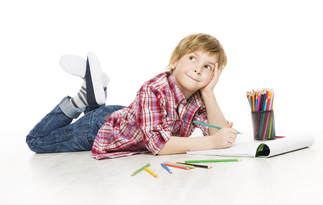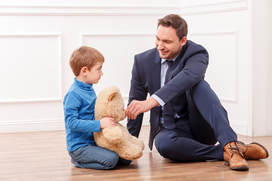 By Emily Kircher-Morris, LPC Because I work with many high-ability, gifted, and twice-exceptional individuals in my practice, I've noticed an interesting pattern with some of my clients. The story follows a specific path: A bright child was diagnosed with ADHD at a young age. Medication after medication had minimal benefit; often the parents abandoned medication altogether. As the child gets older, their lagging social skills cause more and more problems with friends and at school. We finally determine the appropriate diagnosis of Asperger's Disorder has been missed. Many children compensate well for social struggles and concerns may go unnoticed by parents and educators. If the child is gifted, asynchronous development explains many of the quirks the child may show. However, one would expect that as the bright, quirky, asynchronous child grows older, some skills (such as the ability to meet typical social expectations) would balance out. However, the DSM-V says that for a diagnosis of Autism Spectrum Disorder, symptoms may not fully manifest until social demands exceed the abilities of the individual. When a child's struggles increase with age instead of balancing out, a diagnosis of Autism Spectrum Disorder (ASD)/Asperger's should be considered. So, why are these kids given an ADHD diagnosis instead of ASD? A close look at the symptoms of ADHD through the lens of Asperger's can help understand how this misdiagnosis can be made:
Parents, educators, and medical/mental health professionals need to be aware of the overlap of behaviors between these two diagnoses. If medications don't seem to make a difference for ADHD, it may be beneficial to consider the presence of ASD. If social skills seem to be regressing as a child enters late elementary, middle, or high school instead of balancing out, taking a look for Asperger's could help. And finally, considering each of the behaviors that was originally explained by ADHD, and whether the motivation for the behavior is better explained by traits of ASD, can help find an accurate diagnosis. While any mental health diagnosis for a child can be overwhelming, accurately identifying the cause of problematic behaviors allows for proactive interventions to be implemented earlier and with better efficacy.
2 Comments

By Emily Kircher-Morris, LPC
'Tis the season to rack your brain for gift ideas for some of those hard-to-buy-for family and friends. One of the hardest among these is your child's teacher. As parents, we don't really always know the teachers personally enough to get them something they really want. So goes the annual search for a gift that is unique (yet general enough that any teacher would like it) and in the right price range (somewhere between $5 Starbucks gift card and a full spa day). I used to be a teacher and a school counselor. Gift cards are always easy and appreciated but sometimes feel impersonal. Snacks are hard because some teachers don't eat gluten or sugar or coffee or chocolate (What????). Knick knacks and ornaments are tough because, eventually, there just isn't enough space to keep them. So - don't spill the beans to my kids' teachers yet - but here is what they are getting for Christmas this year: I'm giving each of them a gift basket filled with fidgets for their classrooms. Research is showing that more and more students learn better when their psychomotor needs are met. Especially for children with ADHD and other sensory needs, a small, unobtrusive fidget actually can help them focus better than without because it stimulates the small portion of the brain that needs a distraction so the other 95% of the brain can focus on the lesson. Adults need this, too; when I provide professional development, I bring baskets of fidgets, Play-Doh, markers, and candy to fill that sensorimotor need. Now, don't worry. I'm not going to stockpile my child's classroom with a full set of fidget spinners. (I know teachers who've had nightmares about out-of-control fidget spinner mutinies in their classrooms!) When I *teach* kids how to use fidgets appropriately (yes, kids need to be taught how to use fidgets to improve their focus), we have a few rules. The fidget cannot distract others, either visually or by making noise, and the person using the fidget needs to be able to maintain eye contact with the person who is speaking or teaching the lesson. Here are some of my favorite fidgets that I'll be giving my kids' teachers this holiday season. I've bought and tried all of these items and have them at my home and office.
These little tangles are a classic fidget that kids love. They twist and coil and wrap. The one downside is that some kids like to pull them apart and put them back together, which can be distracting in the classroom.
This is perfect for those kids who are always tipping their chairs. Simply wrap this exercise style band around the bottom two legs of a classroom chair for kids to use for counter pressure for their legs. Bonus: It won't result in falling over backwards!
Fun little fidget rings roll up and down a thumb or finger with minimal distraction or noise. They provide some pressure - kind of like a little massage for your finger!
File this under "Why Didn't I Think of That?" This little mesh tube that kind of looks like a little Chinese finger trap has a marble trapped inside. Squeeze the marble back and forth to engage kids without distracting others.
Another style of fidget ring, instead of rolling vertically on the finger, it rolls around the finger. The smooth roll this fidget provides is surprisingly calming and satisfying. Again, it is small and won't be distracting to other kids!
Another great option for the child who has a hard time staying still in his or her seat. These wobble seats take just enough effort for kids to stay stabilized so their wiggling isn't a distraction to themselves or others.
(BTW - These are Amazon Affiliate links. If you opt to purchase through this link, a small portion of your purchase price will be donated to the Gifted Support Network 501(c)(3) nonprofit in St. Charles, MO.)
For example, my son refused to wear a bike helmet more than once. Instead of taking his bike away, he had to research and find information about the risks associated with bike helmet safety and regulations. It was time consuming. I had to help him through the process. It also kept him from his preferred activities, but, it was engaging. It allowed him to create new connections in his awareness of the topic. It was much more effective than me lecturing him, too. And when he was able to share his learning, he felt proud of his work instead of ashamed of his mistake.
The downside of restorative consequences it takes effort, time, and creativity on the part of the parent. However, the long-term benefit in learning and the relationship it fosters between you and your child will be worth the effort. |
Archives
August 2021
Categories
All
|

 RSS Feed
RSS Feed